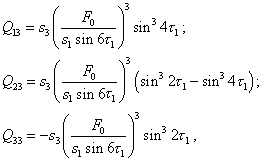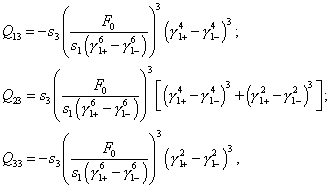| SELF | 34 |
S.B. Karavashkin and O.N. Karavashkina |
|
|
|
| For a purpose of the convenient following analysis,
transform a little (21), using the
values of momentary shifts (15) that
we have found before. At |
|
|
(22) |
| at |
|
|
(23) |
| and at |
|
|
(24) |
We can see from (22)- (24) that the
pattern of the equivalent forces Qi3, out of the resonance region,
depends not only on the amplitude of the first harmonic of momentary shifts, but also on
the pattern of vibration regime in which the first harmonic is present. If the first
harmonic was in the periodical vibration regime, all resonances arising in the first
harmonic reflect in the third harmonic. Still, if the first harmonic is in the aperiodical
vibration regime, the amplitude of equivalent forces of the third harmonic will fall fast
with the frequency; in this problem it is approximately proportional to On the basis of obtained expressions (22)- (24) we can determine the convergence conditions of the series (8) out of the resonance region. For the third harmonic, in absence of that second, this is determined by the criterion of amplitude smallness of equivalent forces of this harmonic in relation to the affecting force amplitude. In order to demonstrate it, it is sufficient to present s1 and s3 through the stiffness of an elastic line T1 and T3 correspondingly: |
|
|
(25) |
| where a is the distance between the non-excited elements of an elastic line. Then under | |
| T3 < T1 | (26) |
| given the condition of non-destructive vibrations in an elastic line is | |
T1 > F0 |
(27) |
| we obtain with (22) | |
|
(28) |
| Thus, we can see that out of the resonance frequency and satisfying the inequality (26), the third harmonic corresponds to a series decreasing in amplitude. However, if (26) was not true, then even with remaining s3 < s1, the convergence of (8) will depend on the affecting force amplitude. At the condition | |
|
(29) |
following from (25) and (26), the third harmonic's amplitude will correspond to the convergent series. In the opposite case out of the resonance band we can observe the growing amplitude of terms of (8) corresponding to the transition to an unstable process. Indeed, this criterion is very approximate and rather demonstrates the fact of presence of stability criterion of the vibration process, and in generalisation, taking into account the following terms of (8), it can be made more precise. None the less, even from this initial evaluation, we can see that in nonlinear systems the affecting force amplitude influences the stability of dynamical process. |
|




